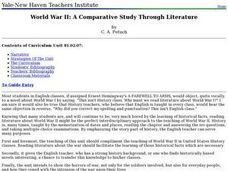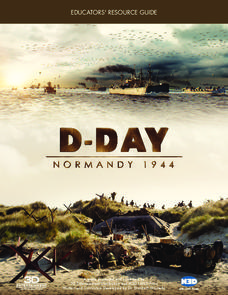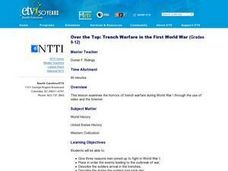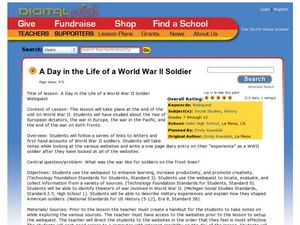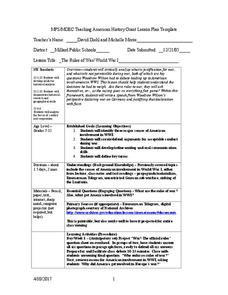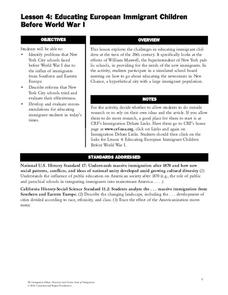Curated OER
World War Two Wordsearch
In this World War II word search worksheet, students locate and circle 17 significant names and terms. A word bank is provided.
Curated OER
United States Entry into World War I: Some Hypotheses About U.S. Entry
Young scholars determine the most compelling evidence explaining why the U.S. entered WWI. They read and discuss a handout of reasons why the U.S. entered the war, and take a poll as to which reason was the most compelling.
Curated OER
World War II: A Compartive Study through Literature
Students examine World War II through the use of literature. As a class, they brainstorm a list of words they relate to the war itself. In groups, they read various novels and view photographs showing the experiences of the Jews,...
Curated OER
Lesson 3: Japan's "Southern Advance" and the March toward War, 1940-1941
High school historians interpret historical evidence presented in primary resources to decide if the southern advance was a reckless step toward war, or if it was reasonable. They research the Japanese southern advance tactics during the...
Smithsonian Institution
Korean War
North and South Korea: two regions divided. The story of the Korean War describes the events that occurred when these two regions' ideologies clashed. The resource uses various images and descriptions of artifacts, in addition to...
National Endowment for the Humanities
People and Places in the North and South
North and South: two opposite directions and two opposite economic and social systems in time of the Civil War. Pupils peruse census websites and primary source photographs to understand what life was like for the everyday person before...
Curated OER
Assignment Discovery Lesson Plan World War II
High schoolers examine primary and secondary documents about life on the homefront during World War II. In this World War II lesson, students research the conditions of daily life in the United Kingdom, the United States, and Germany...
Curated OER
World War II: Concentration Camps and Refugees
Students explore the experiences of the people in the concentration camps at liberation during World War II. Students read an article on the Liberation of Belsen Concentration Camp and D-Day and report to the class.
D-Day Normandy 1944
D-Day Normandy 1944
No study of World War II would be complete without an in-depth examination of the events of June 6, 1944. Pascal Vuong's D-Day Normandy:1944, is the perfect vehicle to convey the sheer magnitude of the events that have been called the...
Curated OER
Over the Top: Trench Warfare in the First World War
Students are able to give three reasons men joined up to fight in World War I. They are able to place in order the event leading to the outbreak of war and describe the soldiers arrival in the trenches. Students are able to describe...
Curated OER
A Day in the Life of a World War II Soldier Webquest
Students complete a web-quest into a day in the life of a World War II soldier. In this webquest lesson, students investigate what life was like for soldiers on the front lines during the second World War. They use note taking skills...
Curated OER
World War II
Students research World War II and discuss how conflicts in the war lead to change. In this World War II lesson plan, students read books, watch movies, complete activity sheets, and answer questions all researching the war.
Curated OER
The Rules of War/World War I
Students explore the reasons the United States became involved in World War I. In this World History lesson, students research the reasons Woodrow Wilson made the decisions he did, prepare a debate and write a paper.
National First Ladies' Library
There's Only How Much? Rationing in World War II
Students discuss the idea of rationing as a restriction on the amount of something or the frequency with which something may be purchased or used in order to contribute to the greater good of the group which was what happened during...
Curated OER
Fighter Pilots of World War II
Students explore the types of airplanes that were used in World War II. For this World History lesson, students write a research paper that compares and contrasts three types of American airplanes and three types of foreign airplanes...
Curated OER
World War I WebQuest
Students reflect on the events before, during and after World War I. In this World History lesson, students complete a WebQuest that focuses specifically on the key events of World War I.
Curated OER
World War I (1914–1919)
In this online interactive history worksheet, students respond to 9 short answer questions about World War I. Students may check some of their answers on the interactive worksheet.
Curated OER
Photographs of the 369th Infantry and African Americans during World War I
Young scholars engage in a discussion regarding images of war we see, how quickly do we see them, and how they affect us? They view and analyze war photographs taken during World War I.
Curated OER
World War I
Eighth graders examine the condition of the world from 1880 until the start of World War I. After watching a PowerPoint presentation, they discuss the causes and effects of the war and complete a study guide with a partner. To end the...
Curated OER
World War I (1914–1919)
In this online interactive history quiz worksheet, students respond to 50 multiple choice questions about World War I. Students may submit their answers to be scored.
Curated OER
World War II
Sixth graders read Under the Blood Red Sun (UBRS), V is for Victory (V), and Number the Stars(NS). They examine WWII through the eyes of Japanese, Danish, and American students and complete at least two projects: a radio broadcast and a...
Curated OER
World War II (1939–1945)
In this online interactive history quiz worksheet, students respond to 50 multiple choice questions about World War II. Students may submit their answers to be scored.
Constitutional Rights Foundation
Educating European Immigrant Children Before World War I
As if surviving a journey to America wasn't enough of a feat for early 20th century immigrants, they then needed to settle into American life. Learn about the ways New York public education attempted to meet the needs of its students,...
Curated OER
Why do wars occur?
Understanding the causes of war is one way (possibly) to prevent it. World War II is used as a case study to facilitate an understanding of reasons why wars start. Topics covered included Totalitarianism, scarcity of resources, need for...




